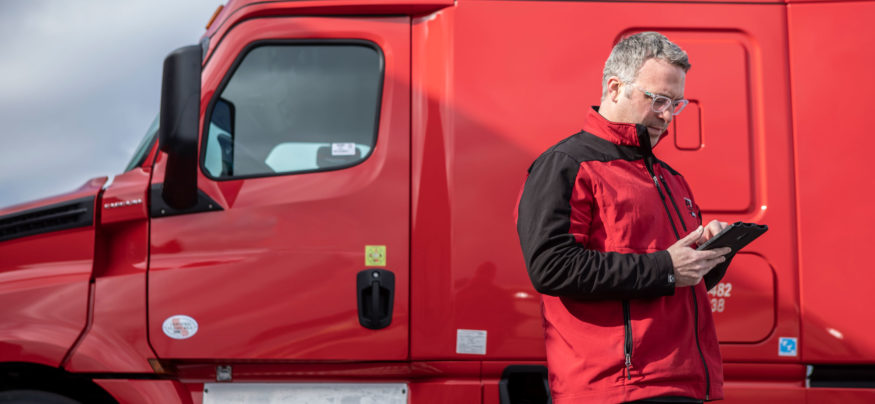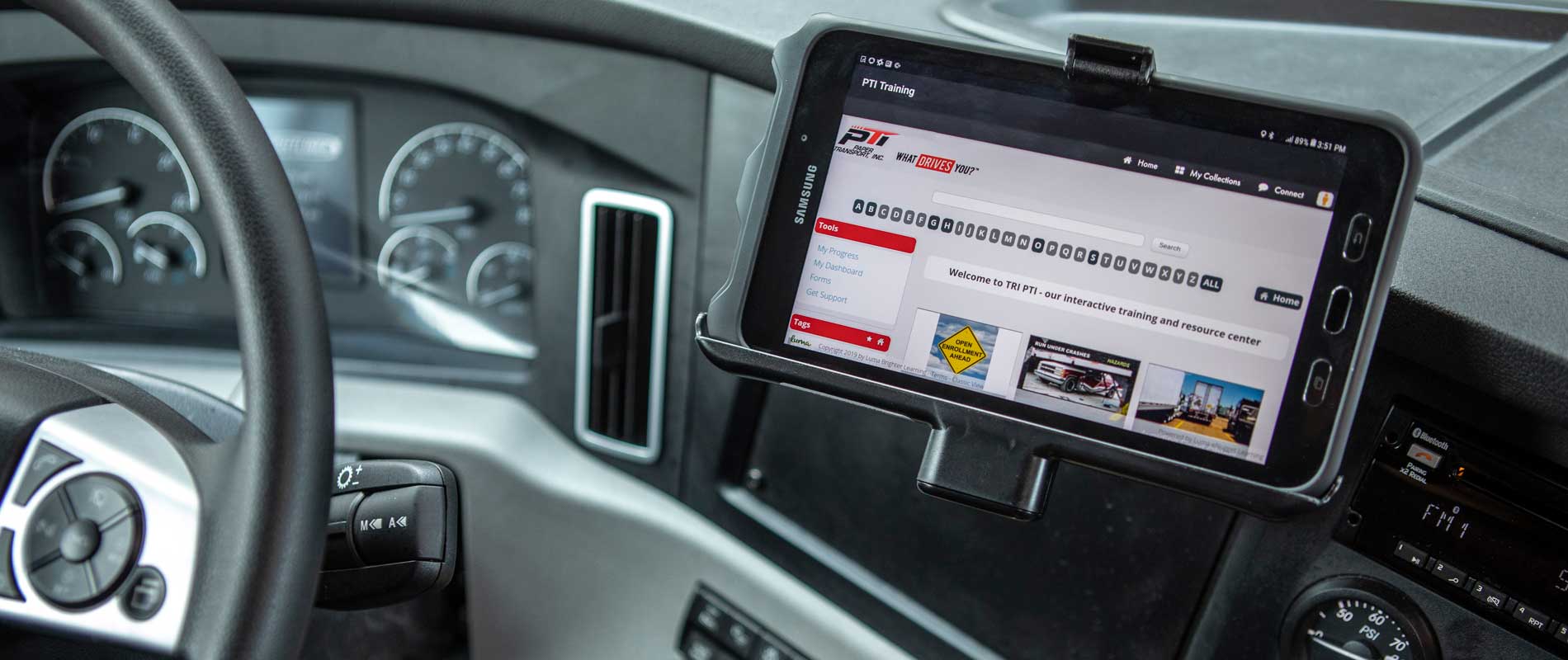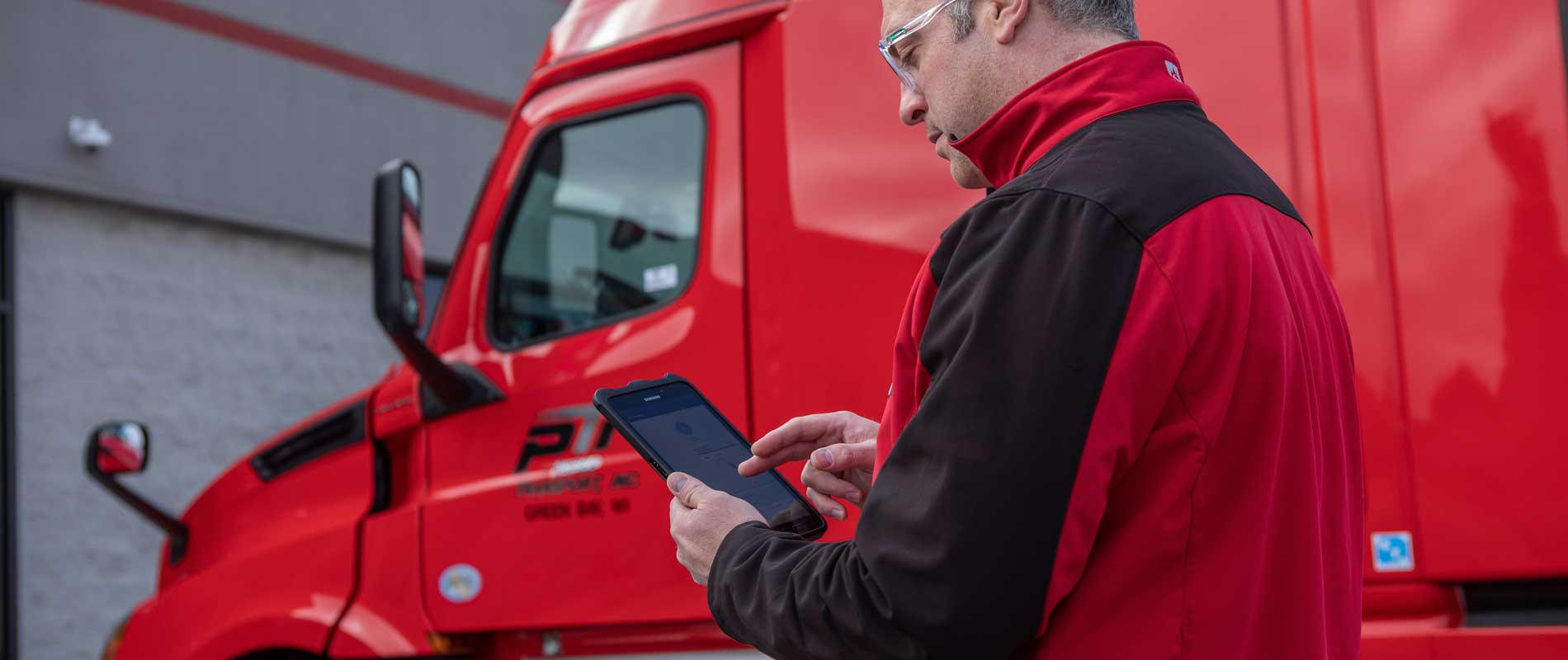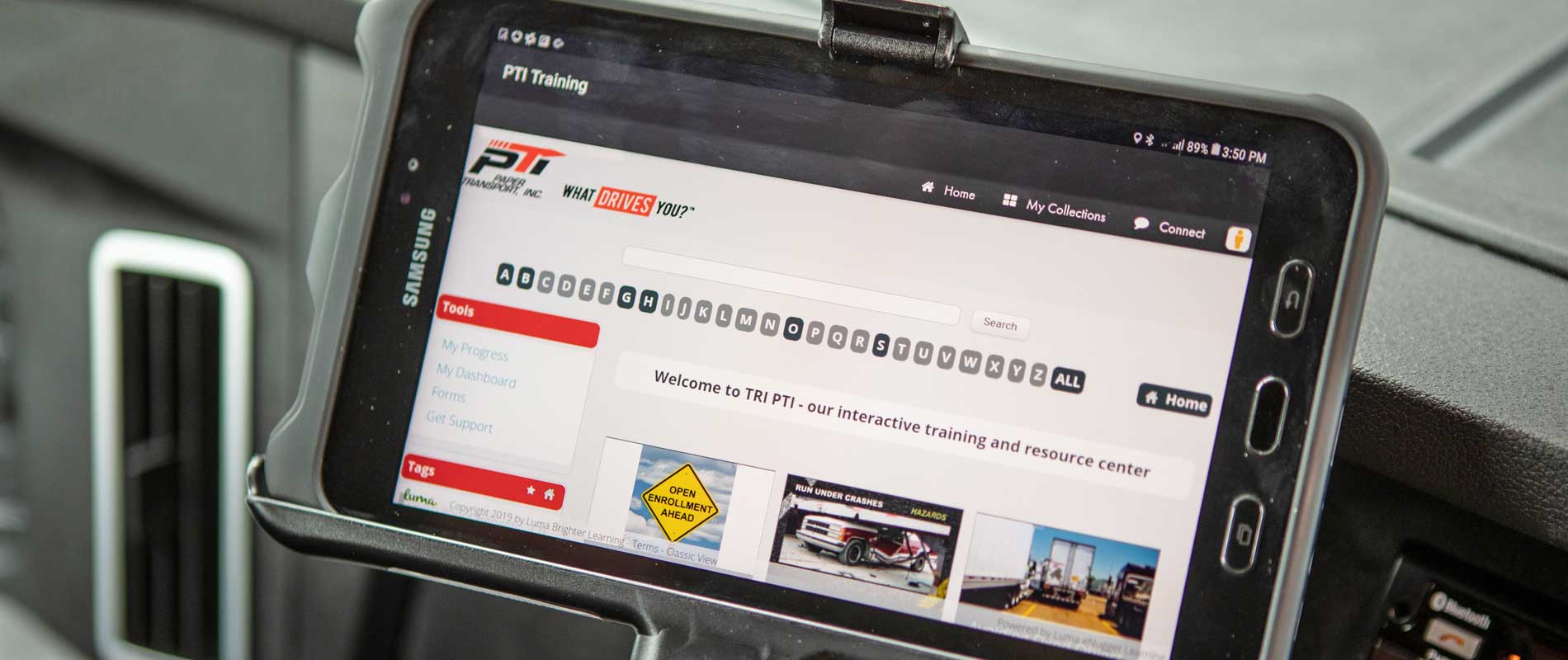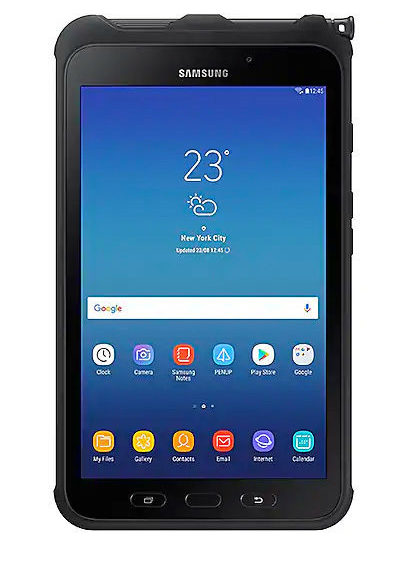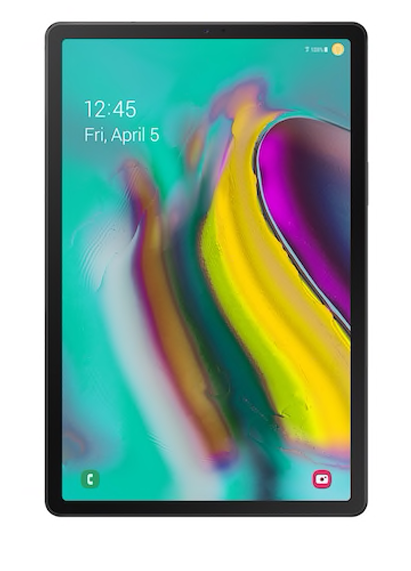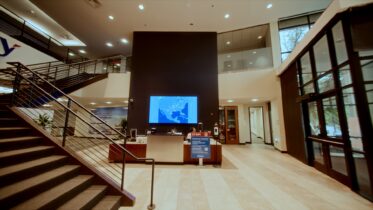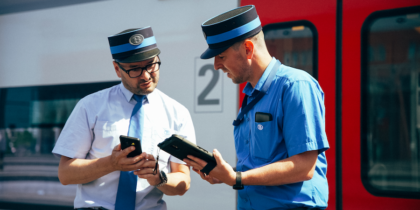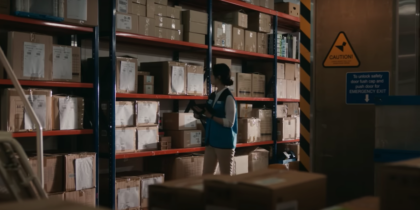
The Challenge
Paper Transport knew that drivers were the backbone of their business, but they faced a problem with attracting and retaining new talent, partly due to outdated technology in their truck cabs. Potential drivers would take one look at the equipment in the cab and walk away from a job offer. With an eye on driver recruitment and retention, Paper Transport was looking to create an exemplary work environment — one where training is made simple and drivers could pursue their ambitions, like continuing their education of the industry to open doors to other opportunities such as attaining a position in company operations. With such an ambitious agenda, they knew it was time to modernize the communication systems in their fleet.
The Solution
Looking for a solution that would include both an open architecture and ease of management of multiple devices, Paper Transport began their journey with a Samsung consumer device in 2015. As they increased their mobile rollout, they began deploying the rugged Samsung Tab Active2. The Omnitracs software program serves as central hub in these tablets, and Paper Transport has also included an in-house app that delivers scorecards for drivers, thereby helping them with ongoing driver training and engagement.
Paper Transport has increased engagement with its ongoing driver education platform. While the company already had a whole suite of videos for driver training and continuing education, those resources were being underutilized until the Samsung solution was instituted.
The Results
Paper Transport modernized its fleet by deploying numerous applications on the Samsung tablets, including hours-of-service logging, route optimization, driver-to-driver communications and a learning management system (LMS). Drivers are able to access a consistent and intuitive experience, which has helped in driver retention and training. In addition, the company has been able to fully utilize its LMS for ongoing driver education. “Driver engagement increased nearly four times, with drivers voluntarily learning from training videos instead of having to be persuaded to do so,” said Peter Covach, director of information technology at Paper Transport.

About the Company
Paper Transport is a Green Bay, Wisconsin-based freight company that employs close to 900 drivers. The truck load carrier has been in business for over 30 years and serves the midwestern, southern and southeastern United States.
Ever since its founding in 1990, Paper Transport has been a technology-focused company, using technology to enable drivers and backend operations.
The Challenge
Recruiting and Retaining Drivers
Paper Transport has been in business for about 30 years, and one of its distinguishing characteristics has been that the company invests heavily in its people. The problem was that Paper Transport’s cab communications system was antiquated and did not meet the needs of today’s fleets. Prospective drivers would take one look at the hardware in the truck cabs and balk. “We had drivers on orientation day that would look at the system we were using and walk out just because of how complex they felt it was,” Covach said. “It was very rigid and outdated.”
There was no way of adding any in-house apps to the device so the fleet could be more productive. Worse, even basic messages such as which order to pick up next would routinely get muddled in the old cab communications system.
Given that driver retention is an ongoing challenge in the trucking industry, the outdated communications system was impeding Paper Transport from achieving their primary business objectives: driver retention and training.
Paper Transport decided it was time to change — and quickly. Given that the scale of the upgrade would be significant, leadership figured they could use the shift to demonstrate a forward-thinking vision for both the company and the drivers. “We knew we could either be a carrier that was stuck in a vision from 10 years ago, or we could be a carrier that truly changes the way drivers interact with the company,” Covach said.
The company needed a solution that could truly excite the workforce and help with driver support. “We wanted to show that we’re trying every day to be better and do better by them. If we’re on a system that can’t provide them new tools or flexibility, then we can’t really support our workforce,” Covach said.
The Solution
Driver-Friendly Tablets and Apps That Enable Training and Support
Paper Transport evaluated potential solutions by a variety of standards. Primary among them: an open-architecture platform that would enable development of in-house programs and apps using a plug-and-play approach. Second, the company was keen on a solution that would be easy to implement and manage across the entire fleet of 850 trucks.
The Samsung tablets quickly became the adopted solution. As Paper Transport continued to modernize, the rugged Tab Active2 met all of these considerations and more. In addition, Paper Transport chose Omnitracs as the workflow management and ELD software that would be installed on these tablets. The company also developed an in-house app that would deliver driver scorecards as a way of cooperatively tracking driver performance. The scorecard allows the driver to track any anomalies in driving patterns or incidents on a daily basis. Drivers can also zero in on speeding events and monitor overall performance. This is one of the ways the app helps Paper Transport with driver training and driver support.
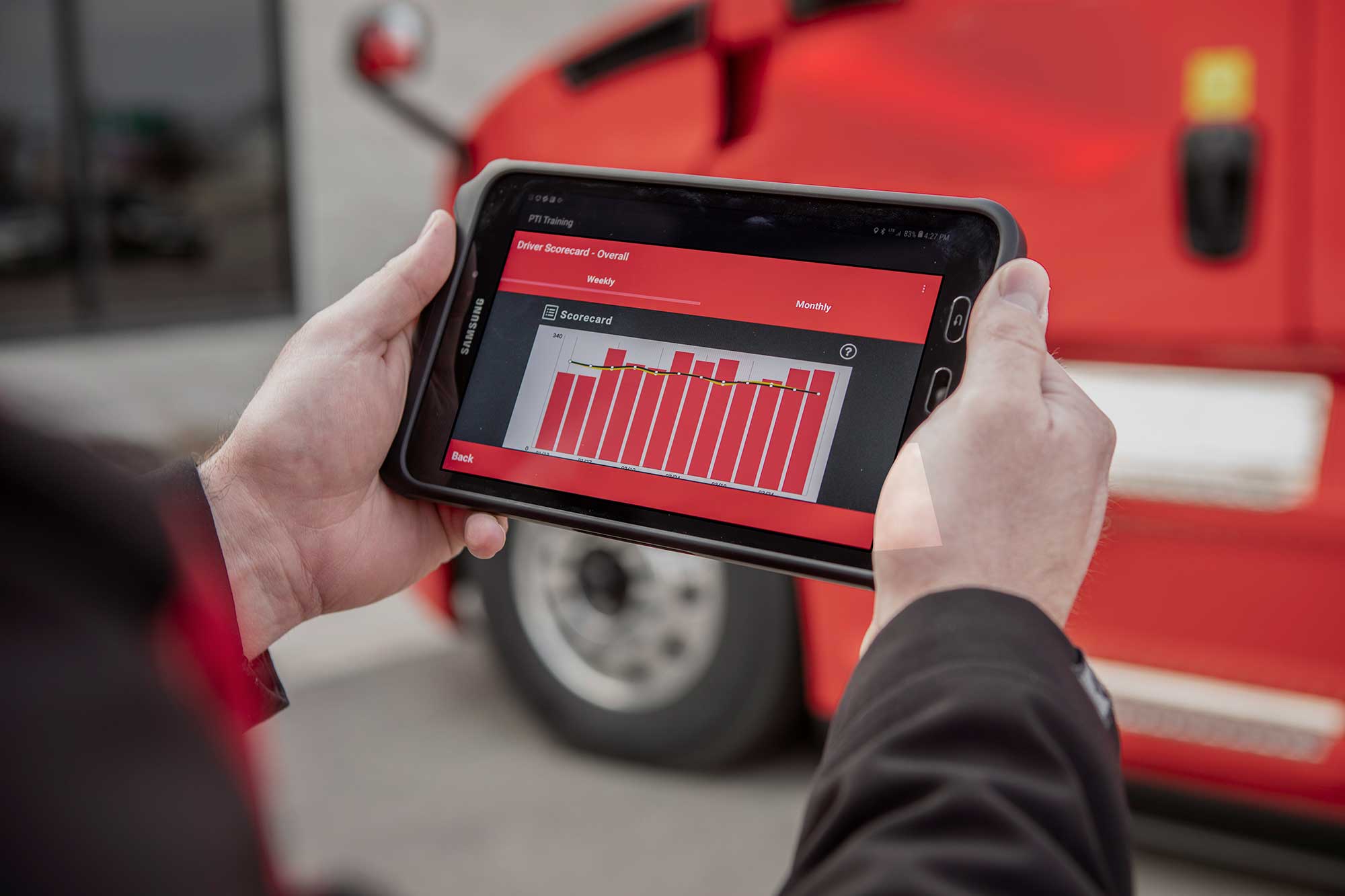
The Samsung devices allowed Paper Transport to easily institute a company-wide MDM policy so all users would access a consistent experience. Samsung’s Knox security and management solutions allow the company to make sure that only approved apps are loaded on the tablets. Through Knox Configure and Knox Manage, the IT department at Paper Transport was able to ensure that certain settings, such as auto-brightness (which is important to eliminate glare for road safety), were also uniform for the entire fleet. Drivers can also choose from a preapproved suite of games from the devices for entertainment during breaks. The company can control data utilization from a cost standpoint.
Equally important, the tablets came preconfigured with the dedicated apps and tools ready to use, so Paper Transport did not have to spend on extensive training and onboarding. “We could have nontechnical people completing the work instead of having technical people trying to ensure the configurations were the same,” Covach said. “That was a huge advantage to be able to effectively distribute and set up the amount of tablets that we have at the scale we did.”
Samsung’s Android-driven open architecture was a big selling point for Paper Transport, as it allowed the company to import specific apps and even create an in-house one tailored to their needs. “I cannot build a foundation on a walled garden. Our choice to continue to purchase the Samsung devices is because Samsung truly continues to be the best solution for us,” Covach said. “Having an open architecture allows us to ensure that we will receive the best-in-class solutions for years to come and that we can provide the best in driver support and driver training.”
The Technology
Galaxy Tab Active 2
A rugged tablet with the tools to drive efficiency.
Galaxy Tab S5e
The Results
A Strengthened Workforce and a Heightened Driver Retention Rate
Paper Transport has registered improvements across the board. “The biggest improvement is in our flexibility,” Covach explained. “When we have new ideas or people ask for new functionality, more often than not I can say yes, or we can talk about how we can work toward it. On the older platforms, that was just a flat-out no. The ability to be flexible and change as we come up with new ideas has been key. We can also choose best-in-breed software, as long as it works on Android.”
Here’s where Paper Transport has made significant progress since deploying Samsung tablets in its truck cabs.
Increasing Fleet Safety
Paper Transport’s drivers significantly reduced speeding events. “When we started showing those events back to the drivers and they knew we were scorecarding them, they started self-managing, because they can see the daily feedback,” Covach said. “That leads to us being a much safer company.”
Increasing Driver Engagement
Paper Transport has increased its driver engagement in a number of ways with the Samsung tablets.
First, because the mobile tablet delivery format is so intuitive and easy to use, Paper Transport has increased engagement with its ongoing driver education platform. While the company already had a whole suite of videos for driver training and continuing education, those resources were being underutilized until the Samsung solution was instituted. With the tablets, Paper Transport could extend the same LMS it used for office staff to drivers, who mostly work remotely. “We saw that drivers now view content multiple times, instead of before, where we had to chase them down to watch training modules every month,” Covach said. The LMS enables drivers to participate in live classroom training, where they can “raise their hand” electronically and engage with the instructor.
Second, the mobile solution has increased engagement between management and the driver, as well as between drivers, keeping everyone on the same page. Through apps, everyone gets the same report on driver and fleet performance: Is too much fuel being used? Is the driver too aggressive? Management can proactively update the workflow with an eye toward lowering total fuel cost and increasing safety. Paper Transport is seeing increased efficiencies by monitoring a variety of such metrics. Since drivers and management receive the same information, drivers are more engaged and the feedback loop has yielded fewer incidences of road events such as speeding. “It’s no longer us versus them. This is a transparent and open conversation about what’s actually happening,” Covach said.
Third, drivers taking a break on the road no longer need to be bored, because they can use the games that come preloaded on the tablets to relax and unwind before hitting the road again, engaged and refueled.
Lastly, with improved communications in all aspects of operations, drivers now have a more influential voice in the company. “Previously they were the silent group, and operations told them what to do,” Covach said. “That is not what drivers want. Now we have a collaborative workforce, with drivers involved in conversations about how we do things.”
Managing the Transition From AOBRD to ELD
The delivery of LMS to the tablets has helped Paper Transport manage the transition from Automatic On-Board Recording Devices (AOBRD) to Electronic Logging Devices (ELD). The company has used the LMS to deliver training on the ELD software remotely to many of its 850 drivers. “The software part of it is easy,” said Covach. “It’s the people part that is hard, and the tablets have helped us leverage the LMS system for this change management.”
Increasing Driver Retention
Paper Transport reduced their turnover from 72 percent to 63 percent, even with a 19 percent growth year over year. “It was a huge advantage to be able to effectively distribute and set up the tablets,” Covach said. “The consistency really allows us to have a scalable deployment into the future. We believe in really developing our people and developing those relationships. We believe we can better our employees’ lives through technology. The strategic initiative for us is that we have to be constantly changing and evolving for our drivers,” Covach said.
To continue the positive trend, Paper Transport is planning on new ways of leveraging the tablets’ Android-based open architecture. Paper Transport will highlight career advancement opportunities and drivers can express interest in open positions right through the tablet.
Having Samsung’s flexibility and ease of management has helped Paper Transport with driver retention and driver engagement, and they hope to continue growing their fleet and advancing their initiatives into the future.
“We’ve got new ideas, new opportunities to implement workflow and communications. This is a really strong platform for us to build on,” Covach said.
Improving Driver Recruitment
The hiring of new drivers, which had been hindered by antiquated in-cab hardware, is greatly improved, and the company is realizing its growth ambitions by expanding its team of drivers to 900. “Our society is getting more data-driven, and people are used to having that data access immediately,” Covach said. “Four to five years from now if you haven’t implemented anything like this, drivers are going to be demanding it, because that is what they have gotten used to from everything else they have experienced in their life. If you’re not building these opportunities for them to improve and maximize what they have, they will be coming to you and demanding it, because competitors will have already done it.”
